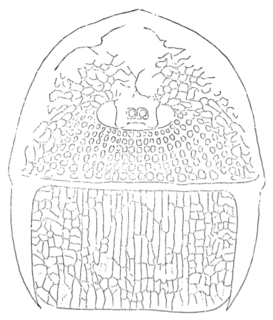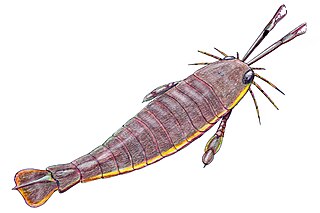
Dolichopterus is a genus of prehistoric sea scorpions, arthropods in the order Eurypterida. Fossils of Dolichopterus have been discovered in deposits ranging from Silurian to Devonian, and have been referred to several different species, some of them of dubious affinity to this genus.

Brachyopterus is a genus of prehistoric eurypterid of the family Rhenopteridae. It is one of the earliest known eurypterids, having been recovered from Middle Ordovician deposits in Montgomeryshire, Wales. Though other species have been assigned to it in the past, Brachyopterus is today recognized as containing one valid species, B. stubblefieldi.
Grossopterus is a genus of prehistoric eurypterid classified as part of the family Waeringopteridae. The genus contains two species, G. inexpectans from Gilboa, United States and G. overathi from Overath, Germany.

Drepanopterus is an extinct genus of eurypterid and the only member of the family Drepanopteridae within the Mycteropoidea superfamily. There are currently three species assigned to the genus. The genus has historically included more species, with nine species associated with the genus Drepanopterus, however five of these have since been proven to be synonyms of pre-existing species, assigned to their own genera, or found to be based on insubstantial fossil data. The holotype of one species proved to be a lithic clast.

Waeringopterus is a genus of prehistoric eurypterids from the Silurian of North America. The genus contains two species, W. apfeli from the Syracuse and Vernon Formations of New York and Ontario and W. cumberlandicus from the Wills Creek Formation, West Virginia. Fossils of the genus also were found in the Indian Point Formation of Quebec.

Kokomopterus is a genus of prehistoric eurypterid. The genus contains a single species, Kokomopterus longicaudatus, known from the Silurian of Kokomo, Indiana.

Erieopterus is a genus of prehistoric eurypterid found in Silurian to Devonian-aged marine strata of Europe and North America. The genus contains eight species from the Silurian to the Devonian, recovered from both North America and Europe.
Tarsopterella is a genus of prehistoric eurypterid classified within the family Hardieopteridae. It contains only one species, T. scotica from the Lower Devonian of Scotland.

Stylonurus is a genus of prehistoric eurypterid of the family Stylonuridae. The genus contains three species: Stylonurus powriensis from the Devonian of Scotland, Stylonurus shaffneri from the Devonian of Pennsylvania and Stylonurus perspicillum from the Devonian of Germany.

Hardieopterus is a genus of prehistoric eurypterid classified within the family Hardieopteridae. The genus contains four species, all Silurian in age; H. lanarkensis and H. macrophthalmus from Scotland, H. megalops from England and H. myops from the United States.

Pagea is a genus of prehistoric eurypterid classified as part of the family Stylonuridae. It contains three species, all from the Devonian; P. plotnicki from Nunavut, Canada and P. sturrocki and P. symondsii from the Old Red Sandstone of the United Kingdom. The genus is named in honor of David Page, an early worker on the fauna of the Old Red Sandstone and describer of the first Stylonurine eurypterid.

Mycterops is a genus of prehistoric eurypterid of the family Mycteroptidae. Mycterops lived during the Carboniferous period in Europe and North America.
Woodwardopterus is a genus of prehistoric eurypterid classified as part of the family Mycteroptidae. The genus contains one species, W. scabrosus, from the Carboniferous of Glencartholm, Scotland.

Laurieipterus is a genus of a eurypterid classified as part of the family Stylonuridae. It contains one species, L. elegans from the Early Silurian of Scotland.

Eurypteroidea are an extinct superfamily of eurypterids. It contains three families and two genera of uncertain classification, Paraeurypterus and Pentlandopterus.
Speleoticus is a spider genus in the family Nesticidae. Its species are found in Japan and China.
Aituaria pontica is an araneomorph spider of the family Nesticidae. It occurs in the Krasnodar region of Russia and in Georgia.

Diploperculata is an infraorder of eurypterids, an extinct group of aquatic arthropods commonly known as "sea scorpions". The name, derived from Greek διπλόω ("double") and operculum, refers to the distinguishing feature that unites the superfamilies included in the group, that the genital operculum is made up of two fused segments.

Onychopterellidae are an extinct family of eurypterids. The family is the only family classified as part of the superfamily Onychopterelloidea. Genera included are Alkenopterus, Onychopterella and Tylopterella.

Moselopteridae are an extinct family of eurypterids. It is the only family classified as part of the superfamily Moselopteroidea, and contains three genera: Moselopterus, Stoermeropterus and Vinetopterus.














